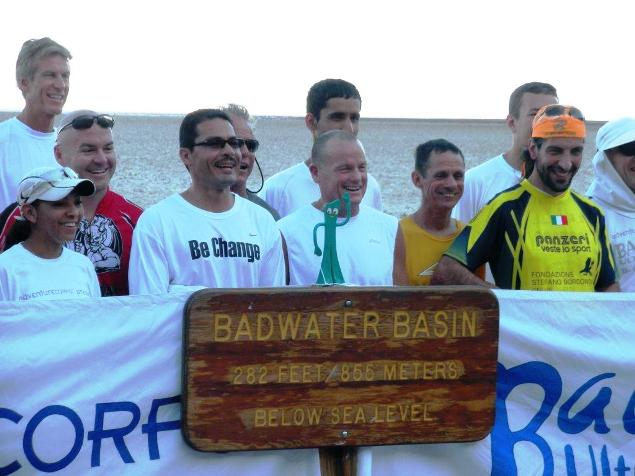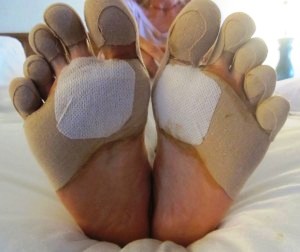
Showing the flexibility of Gumby, Mark Olson (center, front) finished the 135-mile Badwater Ultramarathon in just over 35 hours.
There’s an old saying that goes “If you can’t stand the heat, get out of the kitchen.” On earth, that kitchen is Badwater, Calif., in Death Valley, owner of the second highest temperature ever recorded on Earth at 134 degrees Fahrenheit.
On the morning of July 11, 2011, former Bonita Unified School District librarian Mark Olson set off from Badwater, the lowest point in the United States at 282 feet below sea level, and, with the exception of two 15-minute naps, did not stop running or walking for 35 straight hours until his weary, blistered feet carried him past the finish line at the 8,300-foot base of California’s Mt. Whitney, 135 miles away.
Olson’s time of 35 hours and 7 minutes was the best for his over-60 age group in 2011, and the best for his category, as far anyone can recall, in the history of the Badwater Ultramarathon, known as “the world’s “toughest footrace.”
Olson, age 64, had to overcome not only the physical challenge of running on desert surfaces reaching a rubber sole-melting 200 degrees Fahrenheit and traversing two states and three mountain ranges, but also the mental fatigue of measuring every step over a scorched landscape that taunted him with names like Furnace Creek, Devil’s Cornfield and Stovepipe Wells.
His quest was a race for survival, aided by a pace car that ran about a mile ahead of him and a fresh runner behind him, dedicated to tracking his every wobble so he wouldn’t unconsciously drift across the center divider and into an onrushing 18-wheeler on the open road. For added protection, he wore a reflective vest with flashers.
At the end of the race from hell, Olson wasn’t high-fiving his team the way he would have liked. In 35 hours, he had lost 11 pounds off his usual 5-foot-eight, 157-pound frame, but more than that he was mentally drained.
“Mentally you’re exhausted,” Olson said, looking back at the race exactly 10 days after finishing the grueling test. “That’s because during the race, you spend so much time thinking, ‘Am I okay? Do I need to take water? Do I need food? How’s my foot? How’s my pace?’ All of that is constantly going through your mind.
“I remember as we were driving back into town, my mind was just blank.”
By finishing the world’s toughest foot race, he proved he was one tough, if not slightly delirious, human being who can definitely withstand the heat. Race officials knew that going in. Just to submit an application for the Badwater Ultramarathon, he had to show he had completed three previous continuous 100-mile races. His running resume included such 100-mile tests as the Western States 100 from Lake Tahoe to Auburn, Calif. and the Leadville Trail 100, but not even those grueling ultra-marathons could have prepared him for Badwater, for which hundreds of road warriors annually apply but only a relative few (90) earn an invitation.
In preparation for the race, he would crank up the heat in the sauna at the San Dimas Swim and Racquet club, but instead of sitting in there for the doctor-recommended 10 or 15 minutes, he would sweat it out for 50 minutes or longer. On weekends, he ran for eight or nine-hour stretches at a time.
At first blush, this regimen from hell would hardly seem to fit the profile of a librarian, but Olson, it turns out, is not your typical bibliophile. After graduation from the University of La Verne, San Dimas High School hired him the same year it opened its doors in 1970. He taught biology, chemistry and physical science and also served as the head wrestling coach and assistant football coach.
If that weren’t enough, the adrenaline junkie worked as a river guide in Idaho and Oregon, taking tourists down the Snake, Salmon, Rogue, Klamath and Deschutes Rivers for about two decades. After setting up camp for his river rafters, he often took off jogging on nearby horse and hiking trails to stay in shape. During one summer in the early 80s, he noticed that one of his fellow guides was wearing a big bright belt buckle and when he asked about it, his friend Stick told Olson he got it for finishing the Tahoe- to-Auburn run.
Although Olson had just one marathon under his belt, the idea of running 100 miles intrigued him and he applied, but he had to wait two years before his number was called in the lottery-system, which limits the prestigious race to 300 runners.
Olson now recalls that first ultra-marathon with fondness, forgetting the blisters, cramping, sleeplessness and other physical trials ultra marathoners endure pushing their bodies to the breaking point.

Foot specialist Denise Jones patched up the pounded toes and soles of many runners.
“The gear back then was laughable,” he said. “Fanny packs were as large as garbage bags. For water containers, we used Log Cabin syrup bottles with handles. Despite the crude running aids, he “buckled,” meaning he completed the course within 24 hours and was awarded a shiny, silver buckle.
During that initial ultra-marathon, Olson remembers another runner about 40 miles into the race pointing out a snowcapped mountain range behind them. “I couldn’t believe I had come that far,” he remembered thinking.
Indeed, Olson has traveled a long way in his life’s journey.
After about 17 years of teaching in the classroom and coaching, Olson obtained his library science credential and became San Dimas High School’s librarian for the next 23 years, retiring in 2010 after 40 years. He was the last teacher from the original 1970 San Dimas High School class.
Retirement, of course, has given Olson an open road to try even greater challenges. He’s hardly the shy, retiring type who wants to view life out of the rear view mirror. As they were for him, he wants to be there for his wife Carie, a rodeo barrel jumper, and daughter Ciera, a student at Claremont High School.
No doubt with his librarian’s mind, he’ll also be researching new physical challenges to pursue across the globe. He mentioned the Furnace Creek 508 Bicycle Race that begins in Santa Clarita, arcs through Trona and Death Valley and finishes in Twentynine Palms. Another race called the “Brazil 135” has caught his interest, as well as a winter race in Minnesota where competitors race cross country in snowshoes while dragging their sleds. His bucket list seems to be overflowing.
His pursuits of physical and mental stamina are not cheap, however. Entry fees for some ultra-marathons are approaching $1,000. Then there are lodging and meals to pay for, vans to rent and your team to transport and support, plus all of those doctors visits to keep the body from blowing a gasket or worse.
Seeking a sponsor to help defray some of the cost doesn’t appear to be an option at this point, according to Olson.
“Who’s going to sponsor a 65 year old librarian, Geritol?” Olson asked.
Pushing his limits, time after time, begs the question, why do it at all? Why not just trade in the trail shoes and take up table tennis or canasta?
“I like to compete,” said Olson, whose new haircut makes him look a little like John Glenn, the first American to orbit the earth. “With team roping (in rodeo), you need a partner. In racquetball, you need a partner. In tennis, you need a partner. With running, you don’t need a partner. You don’t have to join a gym or pay an entry fee every time you want to do something.
“You don’t have to keep a schedule. I can run three miles or 10 miles. I can run at nine in the morning or six in the evening. It just lends itself to a flexible schedule, and you still get to compete.”
In a few weeks, Olson will undergo surgery to correct his hammer toe, a deformity in which the end of the toe is bent downward into a claw-like deformity, but after that, he should be back on his feet, conditioning for his next big run.
In at least one sense, the solitary pursuit of running is a lot like running a library. You immerse yourself in it because of the new things you might learn or see. New vistas await determined runners around the next bend as they do for inquisitive readers eager to turn the page in search of new adventure.
“When the sun went down over Death Valley,” Olson said, everything was aglow with these deep intense colors, and in your own way, you felt a part of it.”



Leave a Reply